

| ‘Through the window of science we see the dawn of the Age of Enlightenment.’ —Maharishi |
The following findings are a brief summary of the hundreds of scientific
papers, relevant to the field of crime-prevention and rehabilitation, published
in Scientific Research on Maharishi’s Transcendental Meditation
and TM-Sidhi Programme: Collected Papers—Volumes 1–6 [over
5,000 pages; Volume 7 is in press]. More than 600 scientific studies,
conducted at over 250 independent research institutions in 33 countries,
objectively document the benefits of Maharishi’s Transcendental Meditation
and TM-Sidhi Programme, and prove their extraordinary value to actualize
the highest Vedic ideals of life, bringing fulfilment to the individual
and to all areas of society.
(Refer to: www.tm.org/research/508_studies.html)
These studies are a record of the historic transformation of time, from the scientific age to the Age of Enlightenment, brought about by Maharishi’s teachings, which have opened the gates of enlightenment for millions of people, leading to the establishment of an ideal quality of life for the whole world—Heaven on Earth.
A Brief Summary of Results
An analysis of findings of the numerous studies on crime prevention
through: the Maharishi Effect; the results of studies conducted in
three principal areas of rehabilitation—criminal corrections, the
prevention and treatment of drug abuse and psychiatric rehabilitiation;
and the results of other research of particular relevance to this area
[The numbers within parentheses after each
finding refer to the numbers of the
original research studies as printed in the six volumes of the Collected Papers.]
Prevention of Crime and Social Disorder
through the Maharishi Effect
The following research findings demonstrate that one per cent of a population practising Maharishi’s Transcendental Meditation Technique, or the square root of one per cent collectively practising Maharishi’s TM-Sidhi Programme, radiates a powerful influence of coherence and harmony in collective consciousness, bringing life increasingly in accordance with all the Laws of Nature, neutralizing negative tendencies and promoting positive trends throughout society as a whole.
- Decreased Crime (Vol. 1: 98, Cities, USA, 1973;
Vol. 2: 166, Cities, USA, 1974–1976; Vol. 4: 318, Cities, USA, 1973–1977;
Vol. 4: 319, Cities, USA, 1975–1976; Vol. 4: 320 and Vol. 5: 402,
Cities, USA, 1972–1978, and Metropolitan Areas, USA, 1973–1979;
Vol. 4: 323, USA, 1979; Vol. 4: 325, Holland, 1979 and 1981; Vol. 4: 326
and Vol. 5: 401, Union Territory of Delhi, India, 1980–1981; Vol.
4: 328 and Vol. 5: 402, Washington, DC, USA, 1981–1983; Vol. 4: 333,
Jerusalem and also Israel, 1983; Vol. 4: 334 and Vol. 5: 401, Puerto Rico,
1984; Vol. 4: 337, State of Victoria, Australia; Washington, DC, USA; and
Karachi, Pakistan, 1983–1984; Vol. 5: 401, Metro Manila, Philippines,
1984–1985)
- Decreased Violent Crime (Vol. 4: 323, USA, 1979,
Vol. 5: 402, Washington, DC, 1981–1983)
- Decreased Homicides (Vol. 4: 328, Washington, DC,
USA, 1981–1983)
- Improved Quality of National Life as Measured by an Index Including Crime
Rate, Percentage of Civil Cases Reaching Trial, Suicide Rate, Cigarette Consumption
Rate, Alcohol Consumption Rate, Traffic Fatality Rate, Divorce Rate, Rate
of Infectious Diseases, Infant Mortality Rate, Gross National Product per
Capita, Patent Application Rate, and Degrees Conferred per Capita (Vol.
4: 332, USA, 1976–1983)
- Improved Quality of National Life as Measured by an Index Comprising Data
on Crime, the National Stock Market, and National Mood (Vol 4: 333, Israel,
1983)
- Decreased Fatalities from Suicide, Homicide, and Accidents (Vol.
4: 323, USA, 1979)
- Improved International Relations: Reduced Conflict Globally, Reduced Terrorism, and Increase in World Index of Stock Prices during Three Large Assemblies of Participants in Maharishi’s Transcendental Meditation and TM-Sidhi Programme (Vol. 5: 411, Worldwide, 1983–1985)
Studies Conducted in Prisons Demonstrating
Effective Rehabilitation of Prisoners
- Lower Recidivism (Vol. 3: 285, 286; Vol. 5: 398)
- Fewer New Convictions (Vol. 3: 285, 286)
- Fewer Parole Violations (Vol. 1: 89; Vol. 3: 286)
Improved Psychological Health
- Decreased Anxiety (Vol. 1: 88, 89; Vol. 2: 160;
Vol. 3: 278, 280, 284; Vol. 4: 314)
- Decreased Tension (Vol. 2: 161; Vol. 3: 284)
- Decreased Neuroticism (Vol. 2: 158; Vol. 3: 278,
280)
- Decreased Depression (Vol. 2: 158)
- Decreased Guilt (Vol. 2: 158)
- Decreased Introversion (Vol. 1: 87; Vol. 3: 284)
- Decreased Suspicion (Vol. 2: 158)
- Decreased Resentment (Vol. 2: 158; Vol. 3: 278)
- Decreased Negativism (Vol. 3: 278)
- Decreased Irritability (Vol. 2: 158; Vol. 3: 278)
- Decreased Aggression (Vol. 2: 158; Vol. 3: 278,
284)
- Improved Control of Anger (Vol. 4: 314)
- Decreased Hostility (Vol. 2: 158, 160; Vol. 3: 278,
280; Vol. 4: 314)
- Decreased Schizophrenic Symptoms (Vol. 3: 284)
- Decreased Psychopathic Deviation (Vol. 2: 158; Vol.
3: 284)
- Increased Emotional Stability and Maturity (Vol.
1: 87; Vol. 2: 158)
- Increased Ability to Handle Stress and Tension (Vol.
2: 161)
- Increased Self-Esteem (Vol. 2: 158)
- Greater Self-Development (Vol. 3: 284)
- Growth toward Higher States of Consciousness (Vol. 3: 284)
Improved Behaviour
- Decreased Prison Disciplinary Rule Infractions (Vol.
1: 89; Vol. 2: 160)
- Decreased Use of Drugs and Alcohol (Vol. 1: 89;
Vol. 2: 161)
- Decreased Use of Cigarettes (Vol. 2: 161; Vol. 3:
280)
- Increased Participation in Recreational, Educational, or Business Activities (Vol.
1: 89; Vol. 3: 284)
- Improved Ability to Deal with Others (Vol. 2: 161)
- Improved Work Performance (Vol. 2: 161)
- Decreased Social Introversion (Vol. 1: 87; Vol.
3: 284)
- Decreased Obsessive-Compulsive Behaviour (Vol. 1:
87)
- Improved Quality of Relationships (Vol. 2: 161;
Vol. 3: 284)
- Increased Social Responsibility (Vol. 2: 158)
Effective Rehabilitation of Juvenile Offenders
- Decreased Anxiety (Vol. 1: 90; Vol. 3: 288)
- Positive Change as Reported by Both Subjects and Parents (Vol.
1: 90)
- Increased Happiness and Self-Regard (Vol. 1: 90)
- Reduced Use of Drugs (Vol. 1: 90)
- Improved Relationships (Vol. 1: 90)
- Fewer Court Problems (Vol. 1: 90)
OTHER RESEARCH CONDUCTED ON THE GENERAL POPULATION
SHOWING BENEFITS OF DIRECT RELEVANCE TO THE PREVENTION OF CRIMINAL BEHAVIOUR
AND THE REHABILITATION OF OFFENDERS
A Unique State of Deep Rest during Maharishi’s Transcendental
Meditation Technique—The Perfect Means to Eliminate Stress and
Promote Orderliness in Mental and Physical Functioning
- The Experience of Pure Consciousness Found to Be Associated with High EEG Coherence; Marked Reductions in Respiration Rate, Heart Rate, and Metabolic Rate; Periodic Natural Breath Suspension; Absence of Spontaneous Skin Resistance Responses; High Basal Skin Resistance (Vol. 1: 7; Vol. 3: 197, 205, 213, 218; Vol. 4: 293; Vol. 5: 358)
Increased Coherence of Brain Functioning—The Basis of
Increased Orderliness and Integration in Individual Life
and Increased Coherence in Collective Consciousness
- Increased Orderliness of Brain Functioning (Vol. 1: 1–4, 14–18, 20, 102; Vol. 2: 115, 117, 121; Vol. 3: 205, 210, 211, 213, 215, 217, 218, 224; Vol. 4: 294–296)
Decreased Physiological Stress and
Increased Relaxation during Activity
- More Effective Interaction with the Environment: Improved Resistance to
Stress (Vol. 1: 25–28; Vol. 2: 123; Vol. 5:
370)
- Maintenance of a Relaxed Style of Physiological Functioning outside of
the Practice of Maharishi’s Transcendental Meditation Technique (Vol.
1: 6, 18, 30; Vol. 3: 197; Vol. 5: 356, 358, 359)
- Greater Physiological Calmness during Task Performance (Vol. 2: 122; Vol. 5: 372, 399)
Reduction in Negative Personality Characteristics
- Decreased Hidden Mental Turbulence (Vol. 3: 269)
- Decreased Vulnerability (Vol. 2: 147)
- Decreased Frustration (Vol. 2: 150, 153)
- Decreased Irritability (Vol. 1: 65, 73, 77; Vol.
2: 147, 158, 164; Vol. 3: 278; Vol. 4: 308)
- Decreased Aggressiveness (Vol. 1: 65, 73, 74, 77;
Vol. 2: 147, 158; Vol. 3: 284, 290; Vol. 4: 308)
- Decreased Hostility (Vol. 2: 142, 143, 158, 160;
Vol. 3: 278, 280; Vol. 4: 314)
- Increased Emotional Strength: Decreased Unwelcome Thoughts or Compulsive
Habits (Vol. 2: 150)
- Increased Emotional Harmony and Absence of Regressive Behaviour (Vol.
2: 150)
- Decreased Drug Abuse (Vol. 1: 73, 79–82, 84–86,
89, 90, 95; Vol. 2: 153, 161–163; Vol. 3: 239, 247, 277, 282, 287)
- Decreased Use of Alcohol (Vol. 1: 73, 80, 83–85, 95; Vol. 2: 126, 150, 153, 162, 163; Vol. 3: 239, 247, 282, 287; Vol. 4: 313; Vol. 5: 399)
Growth of Personal Integration and Fulfilment
- Experience of Pure Consciousness during the Practice of Maharishi’s
Transcendental Meditation Technique (Vol. 1: 2, 7,
8, 21, 99–102; Vol. 3: 197, 205, 213, 216, 218, 258)
- Increased Self-Acceptance (Vol. 1: 70, 81; Vol.
2: 151)
- Increased Self-Confidence and Self-Assuredness (Vol.
1: 65, 77; Vol. 2: 150, 164; Vol. 3: 261, 277, 290; Vol. 4: 308)
- Enhanced Inner Well-Being (Vol. 2: 125, 147; Vol.
4: 310; Vol. 5: 395)
- Increased Inner Calm and Tranquillity (Vol. 1: 65,
73, 77; Vol. 2: 150; Vol. 4: 308, 316)
- Increased Contentment (Vol. 1: 65, 67, 77; Vol.
2: 150; Vol. 3: 277, 290; Vol. 4: 308)
- Increased Happiness (Vol. 1: 90; Vol. 2: 147, 165;
Vol. 4: 308)
- Increased Emotional Stability (Vol. 1: 65, 71, 77,
87, 93, 95; Vol. 2: 150, 153, 158; Vol. 3: 241, 273, 277, 290; Vol. 4:
308)
- Increased Moral Maturity (Vol. 1: 91; Vol. 3: 265,
270; Vol. 4: 309)
- Increased Altruism (Vol. 1: 71; Vol. 2: 138)
- Improvements in Mental Health Positively Correlated with Duration and Regularity of Practice of Maharishi’s Transcendental Meditation Technique (Vol. 3: 247)
Growth of Ideal Social Behaviour
- Increased Ability to See Man as Essentially Good (Vol.
1: 76; Vol. 2: 153; Vol. 3: 266)
- Increased Social Maturity (Vol. 2: 138; Vol. 3:
261)
- Greater Sense of Social Responsibility (Vol. 2:
138, 158)
- Increased Sociability (Vol. 1: 65, 73, 77; Vol.
2: 138; Vol. 3: 261, 266, 277, 290; Vol. 4: 316)
- Less Sense of Social Inadequacy (Vol. 3: 266)
- Increased Capacity for Warm Interpersonal Relationships (Vol.
1: 69, 70, 73, 76, 77; Vol. 2: 149, 151, 153; Vol. 3: 277, 284, 290; Vol.
4: 316)
- Decreased Tendency to Dominate (Vol. 1: 65, 77;
Vol. 3: 268, 277, 290)
- Increased Good-Naturedness, Friendliness, and Loyalty (Vol.
1: 73)
- Increased Tolerance (Vol. 1: 62, 65; Vol. 2: 153,
164; Vol. 3: 266, 277, 290; Vol. 4: 308, 316)
- Increased Sensitivity to the Feelings of Others (Vol.
1: 73; Vol. 4: 304, 316)
- Growth of a More Tactful, Forgiving, and Agreeable Nature (Vol.
1: 73; Vol. 2: 153)
- Greater Satisfaction with Marriage:
- Greater Happiness (Vol. 2: 165)
- Greater Harmony (Vol. 2: 165)
- Greater Acceptance of One’s Spouse (Vol. 2: 165)
- Greater Happiness (Vol. 2: 165)
Increased Clarity and Orderliness of Thinking
- Increased Intelligence (Vol. 1: 53–55, 62,
103; Vol. 2: 150; Vol. 3: 257, 261, 265; Vol. 4: 307; Vol. 5: 382, 387,
389, 390, 392, 393)
- Increased Mental Clarity and Wakefulness (Vol. 2:
147)
- Increased Foresight (Vol. 2: 153)
- Increased Practicality and Realism (Vol. 2: 153)
- Enhanced Creativity (Vol. 1: 62, 63, 103; Vol. 2:
150; Vol. 3: 257, 260; Vol. 4: 294, 304, 305; Vol. 5: 392, 395)
- Improved Problem-Solving Ability (Vol. 1: 58, 62)
Improved Performance and Increased Work Satisfaction
- Increased Job Satisfaction (Vol. 1: 96, 97; Vol.
5: 399)
- Decreased Desire to Change Jobs (Vol. 1: 96)
- Improved Relations with Supervisors (Vol. 1: 96, 97)
Growth of Perfect Health
- Improved Health of the Nervous System (Vol. 1: 1–4,
14–18, 20, 21, 25–28, 43, 45–49, 53–56, 58, 62,
63, 87, 102–104; Vol. 2: 114–117, 120, 123, 129–131,
134, 135, 140; Vol. 3: 202, 205, 210, 211, 213–219, 221, 223, 224,
226, 227, 229–231, 245, 246, 248, 250–254, 257, 258, 260, 265;
Vol. 4: 294–296, 298, 301; Vol. 5: 370–375, 378, 390, 393)
- Improved General Health (Vol. 1: 2, 40–42, 44, 95; Vol. 2: 125–127, 150, 153, 157, 160; Vol. 3: 232, 238, 239, 241, 243, 247, 278, 280, 290; Vol. 4: 300, 314; Vol. 5: 377–380, 399)
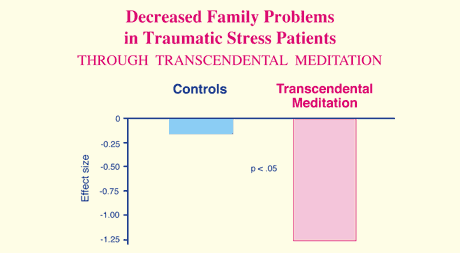
| Patients seeking treatment for traumatic stress who learnt the Transcendental Meditation Programme showed a significant reduction in family problems, in comparison to those receiving psychotherapy. Reference: Journal of Counseling and Development 64: 212–215, 1985. |
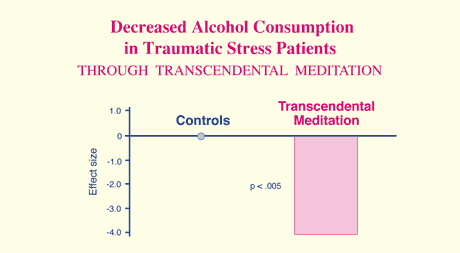
| Patients seeking treatment for traumatic stress who learnt the Transcendental Meditation Programme showed a significant reduction in alcohol consumption, in comparison to those receiving psychotherapy. Reference: Journal of Counseling and Development 64: 212–215, 1985. |
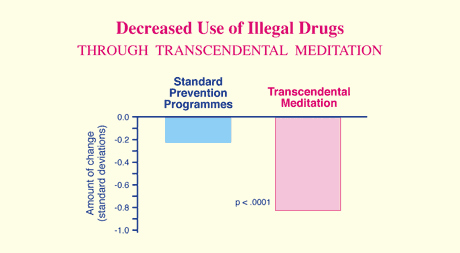
| A meta-analysis of all relevant research studies found that those who had been using illegal drugs showed a substantial and long-lasting reduction in the use of such drugs after learning the Transcendental Meditation Programme. This reduction in drug use was significantly greater than the effect of standard prevention programmes for reducing drug use. Reference: Alcoholism Treatment Quarterly 11: 13–87, 1994. |
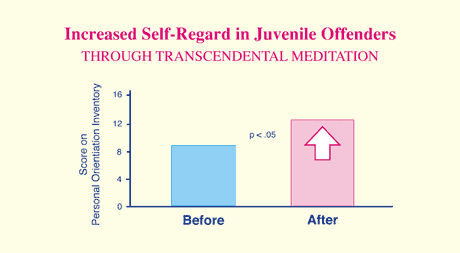
| Young people referred to juvenile court for a legal offence showed a significant increase in self-regard after learning the Transcendental Meditation Programme. Reference: Dissertation Abstracts International 34(8): 4732A, 1974. |
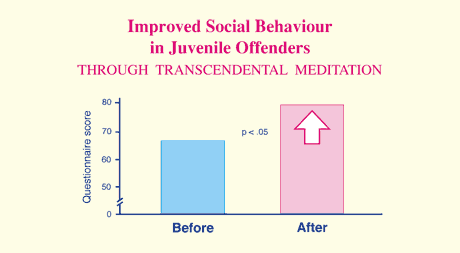
| Young people referred to juvenile court for a legal offence showed a significant improvement in social behaviour, as assessed by parents, after learning the Transcendental Meditation Programme. Reference: Dissertation Abstracts International 34(8): 4732A, 1974. |
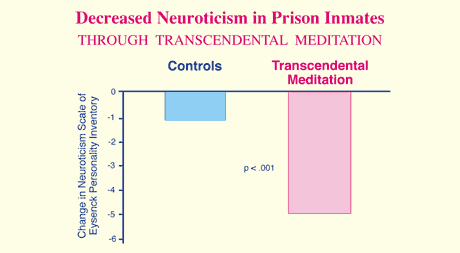
| Maximum-security prison inmates who learnt the Transcendental Meditation Programme showed decreased neuroticism, in comparison to controls. Reference: Criminal Justice and Behavior 5: 3–20, 1978. |
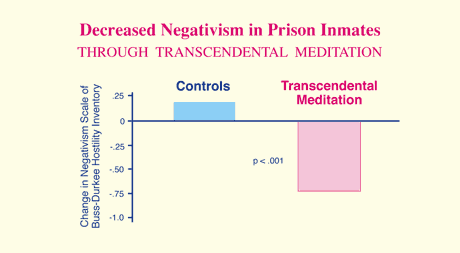
| Maximum-security prison inmates who learnt the Transcendental Meditation Programme were found to have decreased negativism, in comparison to controls. Reference: Criminal Justice and Behavior 5: 3–20, 1978. |
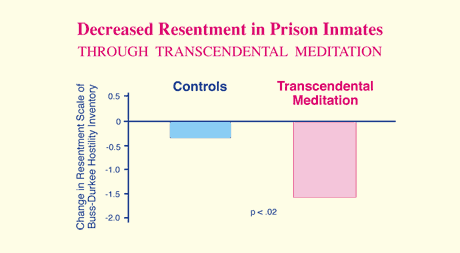
| Maximum-security prison inmates who learnt the Transcendental Meditation Programme showed decreased resentment, in comparison to controls. Reference: Criminal Justice and Behavior 5: 3–20, 1978. |
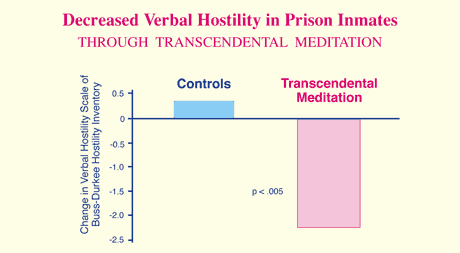
| Maximum-security prison inmates who learnt the Transcendental Meditation Programme were found to have decreased aggression, in comparison to controls. Reference: Dissertation Abstracts International 43(2): 539B, 1982. |
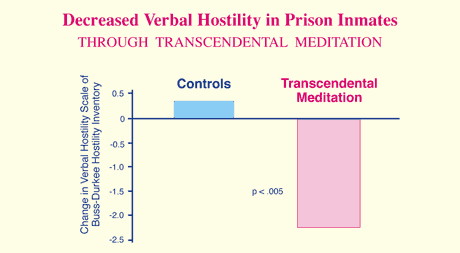
| Maximum-security prison inmates who learnt the Transcendental Meditation Programme expressed decreased verbal hostility, in comparison to controls. Reference: Criminal Justice and Behavior 5: 3–20, 1978. |
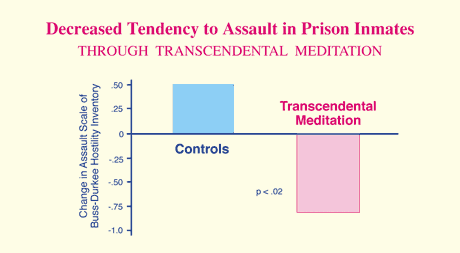
| Maximum-security prison inmates who learnt the Transcendental Meditation Programme were found to have decreased tendency to assault, in comparison to controls. Reference: Criminal Justice and Behavior 5: 3–20, 1978. |

| Maximum-security prison inmates who learnt the Transcendental Meditation Programme showed decreased insomnia and better quality of sleep, in comparison to controls. Reference: Criminal Justice and Behavior 5: 3–20, 1978. |
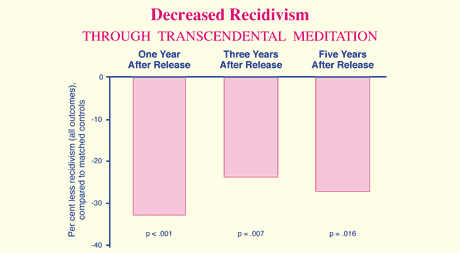
| Parolees of the California Department of Corrections who learnt the Transcendental Meditation Programme while in prison showed significantly decreased recidivism, combining all parole outcomes over a five-year period after release, in comparison to matched controls. Reference: Journal of Criminal Justice 15: 211–230, 1987. |
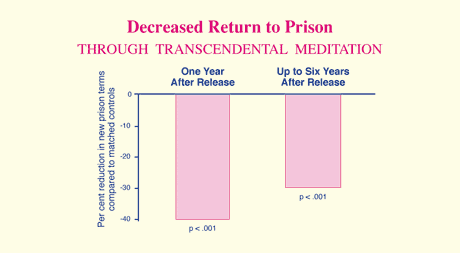
| Parolees of the California Department of Corrections who learnt the Transcendental Meditation Programme while in prison showed significantly fewer new prison terms, in comparison to matched controls, at one year after release and overall from six months to six years after release. In contrast, prison education, vocational training, and counselling programmes had no consistent effect. Reference: Journal of Criminal Justice 15: 211–230, 1987. |
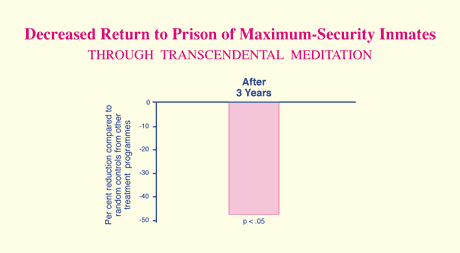
| A doctoral dissertation at Harvard University found that inmates in a maximum-security prison who learnt the Transcendental Meditation Programme showed significantly decreased return to prison after at least 36 months, in comparison to random samples of participants of four other prison rehabilitation programmes, controlling for time of release from prison. Reference: Dissertation Abstracts International 43(2): 539B, 1982. |
Following are just a small sample of the many case studies conducted over the years, upon which the above findings are based, found published in the volumes of Scientific Research on Maharishi’s Transcendental Meditation and TM-Sidhi Programme—Collected Papers:
Abrams, A.I. and Siegel, L.M. (1978). The Transcendental Meditation program and rehabilitation at Folsom State Prison: A cross-validation study. Criminal Justice and Behavior 5(1): 3–20.
Alexander, C.N. (1982). Ego development, personality, and behavioral change in inmates practicing the Transcendental Meditation technique or participating in other programs: A cross-sectional and longitudinal study (Doctoral dissertation, Harvard University). Dissertation Abstracts International, 43(2), 539-B.
Alexander, C.N., Robinson, P., & Rainforth, M.V. (1994). Treating and preventing alcohol, nicotine, and drug abuse through Transcendental Meditation: A review and statistical meta-analysis. Alcoholism Treatment Quarterly 11(1), 13–87.
Bleick, C.R. and Abrams, A.I. (1987). The Transcendental Meditation program and criminal recidivism in California. Journal of Criminal Justice, 15(3), 211–230.
Dillbeck, M.C. & Abrams, A.I. (1987). The application of the Transcendental Meditation program to correction. International Journal of Comparative and Applied Criminal Justice 11(1): 111–132.
Gelderloos P., Walton, K.G., Orme-Johnson, D.W., & Alexander, C.N. (1991). Effectiveness of the Transcendental Meditation program in preventing and treating substance misuse: A review. International Journal of the Addictions, 26, 293–325.
Lidberg, L., Tuck, J.R., Asberg, M., Scalia-Tomba, G.P., & Bertilsson, L. (1985). Homicide, suicide, and CSF 5HIA. Acta Psychiatr Scand 71, 230–236.
Orme-Johnson, D.W., Alexander, C.N., Davies, J.L., Chandler, H.M., & Larimore, W.E. (1988). International peace project in the Middle East: The effects of the Maharishi Technology of the Unified Field. Journal of Conflict Resolution, 32, 776–812.
Gore, W.W.; Abrams, A.; and Ellis, G. The effect of state-wide implementation of the Maharishi Technology of the Unified Field in the Vermont Department of Corrections. Institute for Social Rehabilitation, Burlington, Vermont, USA, 1984.
Walton, K.G. & Levitsky, D. (1994). A neuroendocrine mechanism for the reduction of drug use and addictions by Transcendental Meditation. Alcoholism Treatment Quarterly, 11(1), 89–117.
In Addition
The following book reviews the numerous studies on Maharishi’s Transcendental
Meditation Programme conducted over the past three decades in criminal justice
systems around the world:
Transcendental Meditation in Criminal Rehabilitation and Crime Prevention
Editors: C. N. Alexander, PhD; K.G. Walton, PhD; D. Orme-Johnson, PhD; R.S. Goodman, PhD; N.J. Pallone, PhD. Haworth Press, 2003. Printed as a double issue of the Journal of Offender Rehabilitation. 394 pages. Softcover: ISBN 0-7890-2037-8 and hardcover: ISBN 0-7890-2036-x.
From the Table of Contents:
- The Transcendental Meditation Program: A Consciousness-Based Developmental
Technology for Rehabilitation and Crime Prevention
- HIGHLIGHT: A COMMUNITY-BASED SENTENCING PROGRAM FOR PROBATIONERS
- The Enlightened Sentencing Project: A Judicial Innovation
- The Enlightened Sentencing Project: A Judicial Innovation
- SECTION I: THEORY AND REVIEW
- Effectiveness of the Transcendental Meditation Program in Criminal
Rehabilitation and Substance Abuse Recovery: A Review of the Research
- Effects of the Transcendental Meditation Program on Neuroendocrine
Abnormalities Associated with Aggression and Crime
- Effectiveness of the Transcendental Meditation Program in Criminal
Rehabilitation and Substance Abuse Recovery: A Review of the Research
- SECTION II: ORIGINAL RESEARCH ON REHABILITATION
- First Prison Study Using the Transcendental Meditation Program: La
Tuna Federal Penitentiary, 1971
- Walpole Study of the Transcendental Meditation Program in Maximum Security
Prisoners I: Cross-Sectional Differences in Development and Psychopathology
- Walpole Study of the Transcendental Meditation Program in Maximum Security
Prisoners II: Longitudinal Study of Development and Psychopathology
- Walpole Study of the Transcendental Meditation Program in Maximum Security
Prisoners III: Reduced Recidivism
- Effects of the Transcendental Meditation Program on Recidivism Among
Former Inmates of Folsom Prison: Survival Analysis of 15-Year Follow-Up Data
- Consciousness-Based Rehabilitation of Inmates in the Netherlands Antilles:
Psychosocial and Cognitive Changes
- SECTION III: PREVENTING CRIME AND VIOLENCE
- Attacking Crime at Its Source: Consciousness-Based Education in the
Prevention of Violence and Antisocial Behavior
- Preventing Crime Through the Maharishi Effect
- Preventing Terrorism and International Conflict: Effects of Large Assemblies
of Participants in the Transcendental Meditation and TM-Sidhi Programs
- Attacking Crime at Its Source: Consciousness-Based Education in the
Prevention of Violence and Antisocial Behavior
- SECTION IV: TRANSCENDENTAL MEDITATION IN PRISONS AND PRISON SYSTEMS
- The Transcendental Meditation Program in the Senegalese Penitentiary
System
- Cost Savings from Teaching the Transcendental Meditation Program in Prisons
- The Transcendental Meditation Program in the Senegalese Penitentiary
System
‘This comprehensive review of TM (Transcendental Meditation) in criminal justice management is sure to find a place in the literature on corrections and crime control, and should become REQUIRED READING FOR STUDENTS OF SUBSTANCE ABUSE TREATMENT AND ADDICTION. … The book’s principal message—that crime is preventable, criminals are redeemable, and successful social control derives from durable, sustainable self-control—emerges straight from the data. Impressive, compelling … it challenges conventional approaches to crime control.’Alan Mobley, PhD, Faculty Fellow,
Department of Criminology, Law & Society, School of Social Ecology,
University of California, Irvine
Example of a case study presented in this book,
on the entire Correctional
System of Senegal
A large demonstration project conducted in Senegal, West Africa showed dramatic results. Between 1987 and 1989, Maharishi’s Transcendental Meditation Technique was taught to all inmates in thirty-one of the thirty-four prisons; eleven thousand inmates and nine hundred correctional officers practised the Transcendental Meditation Technique regularly during the two-year project. This project differed from those in U.S. prisons in that all correctional officers practised the programme, and all inmates practised Transcendental Meditation together.
This comprehensive approach appeared to have a marked effect on recidivism. The results were summarized in a letter from Colonel Mamadou Diop, Director of the Penitentiary Administration:
‘In Senegal usually about 90% of the inmates released after serving their sentence come back to prison within one month. However, six months after 2,000 meditating inmates were released in 1988, we could register less than forty recidivists (a 2% return rate). … Considering that there is no structure or scheme for the reintegration of inmates into society, nor is there any provision for work or jobs for those released, it appears that the only possible explanation for this remarkable drop in recidivism in our country is to be found in the application of your programme.’
(Diop 1988, quoted by Anklesaria, F. (1990) in:
New Horizons in Criminology and Penitentiary Science:
The Maharishi Unified Field Based Integrated System of Rehabilitation in Senegalese Prisons,
Vlodrop, The Netherlands: Maharishi Vedic University Press, page 159.)
For further review of the remarkable findings on Maharishi’s Transcendental
Meditation in criminal rehabilitation and crime prevention, visit:
www.enlightenedsentencing.org/summary-of-scientific-research.htm
In Conclusion
Maharishi spoke the following words over forty years ago. The truth of these words is reflected for all times in the vast body of scientific research conducted on Maharishi’s Vedic Science and Technology since then:
‘Generation after generation man is born anew. Each generation gives rise to new aspirations in life and brings a new quest for fulfilment. Each man needs sound physical and mental health, greater ability in action, a greater capacity to think clearly, increased efficiency in work, and more loving and rewarding relationships with others. He needs enough vitality and intelligence to satisfy the desires of his mind and bring contentment to his life. We have seen that all this can be gained through the regular practice of Transcendental Meditation.
‘… A new humanity will be born, fuller in conception and richer in experience and accomplishments in all fields. Joy of life will belong to every man, love will dominate human society, truth and virtue will reign in the world, peace on earth will be permanent, and all will live in fulfilment in fullness of life in God Consciousness.’
Science of Being and Art of Living—Transcendental Meditation
[374-page publication]
Rehabilitation: www.istpp.org/rehabilitation/index.html
Crime Prevention: www.istpp.org/crime_prevention/index.html
and http://ff.mum.edu/mumpress/p_k03.html
Also visit: www.TruthAboutTM.com